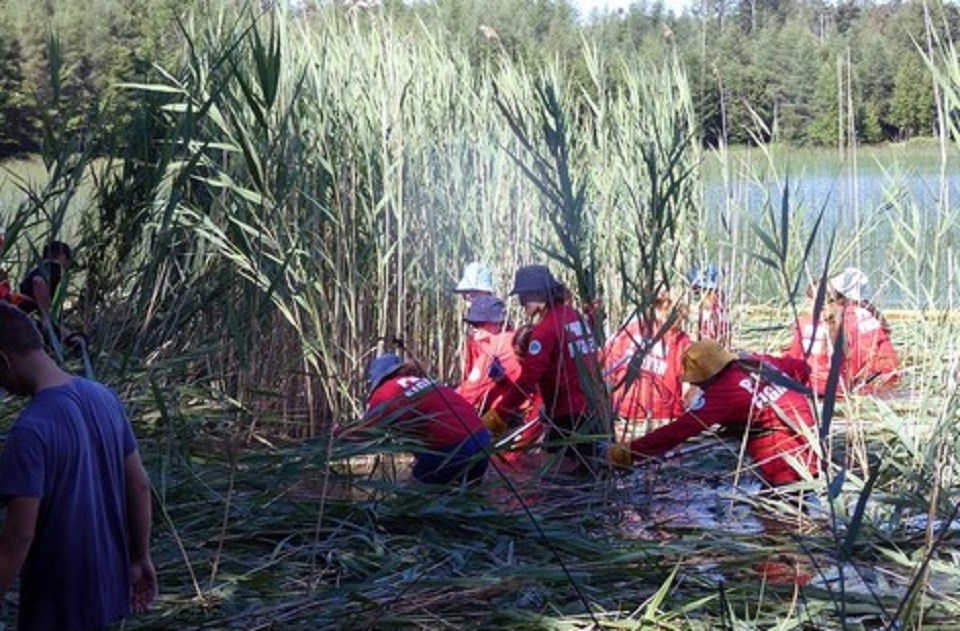The chair of the Phragmites Working Group Lake Bernard has a request for Sundridge, Strong and Joly.
Marilee Koenderink is asking the three municipalities to promote a clean equipment policy when heavy equipment is brought in to carry out roadwork or construction in any of the three municipalities.
The policy is being advanced by the Ontario Phragmites Working Group. The rationale behind the request is to stop the spread of phragmites.
Phragmites are invasive plants that spread quickly and easily chokes out native species.
See: Fast invading plant threatening local wetlands
And: Five invasive plant species found in local area
In addition to out-competing native plants, phragmites are also a threat to the local fishery, turtle population, birds and amphibians.
Phragmites, which appear as tall reed grass, also have no natural predators to keep their numbers down.
Once they appear, the only sure way of getting rid of them is to dig, cut or spade them out with a shovel.
Koenderink is promoting the clean equipment policy because phragmites seeds easily embed themselves on the tires or tracks of heavy equipment.
Once they land on heavy equipment it's one of the easiest ways for them to spread from one location to another.
Phragmites are also known to spread when they attach themselves to the tires of ATVs or tracks of snowmobiles.
Phragmites have been present in the Lake Bernard area for about 10 years. They have also invaded Lake Nipissing.
Koenderink told a meeting of all three municipalities her exposure to phragmites occurred when one day she noticed a green plant taking over an area of her property. She didn't do anything about it for a good reason.
“I thought the MNRF (Ministry of Natural Resources and Forestry) would be after me if I did anything to an aquatic plant,” she said.
“By the time we figured out it wasn't a native plant, about one-third of my property was covered and the phragmites completely covered the property next to mine.”
The phragmites didn't take long to spread across the area.
Each June for the last few years, about 100 volunteers known as Phrag Fighters have undertaken an operation to remove the invasive plant in various sections of the Lake Bernard area.
By mid-July, after the fish spawning season has ended, they wade into the water to remove as much of the plants as they can until October.
Koenderink says the volunteers, many of them Lake Bernard property owners, will follow the same plan this year.
Koenderink says there are 34 known phragmites sites across Lake Bernard. The goal is to achieve a phrag-free environment in the region by about 2033.
Phragmites can grow almost anywhere and Koenderink has seen the plants grow through asphalt and destroy ditches.
A major reason why it's able to take over an area very quickly is that each plant can produce up to 2,000 seeds, which begin growing where they fall. Those seeds also get to other areas when they become attached to heavy equipment or recreational vehicles.
Koenderink notes they can also get on to boats. That's why the local group is promoting a clean, drain, and dry program for area boaters so they don't inadvertently spread the plant.
“We know it's present on other Almaguin lakes but we don't know how many,” Koenderink told the tri-council.
One objective is to get more property owners to recognize what the plant looks like so they can take steps to remove it early on.
If that happens, the task of removing the phragmites increases severalfold.
“You might not know you have it right away,” Koenderink said.
“There may be a lot of people like me who initially think it's a native aquatic plant and don't do anything about it.”
When people attempt to remove phragmites, what they see before them is a plant that's about 15 feet tall.
But that's only part of it.
The plant can be a further 30 feet underground. Its depth is a major reason it's difficult to eradicate any specific area in one season.
Koenderink says in some cases the Phrag Fighters have worked the same site two and three years in a row, but that persistence has finally paid off with less of the plant making a return in those areas.
Koenderink commends the volunteers who, in addition to living in the Sundridge area, also come in from Burk's Falls, Magnetawan and Kearney to help.
And there's a big age gap among the volunteers.
Koenderink says the ages range from a three-year-old to one individual who is over 80.
In the near future, the local group plans to put together a webinar to help people recognize the difference between phragmites and native plants so they know what to remove.
Rocco Frangione is a Local Journalism Initiative reporter who works out of the North Bay Nugget. The Local Journalism Initiative is funded by the Government of Canada.



